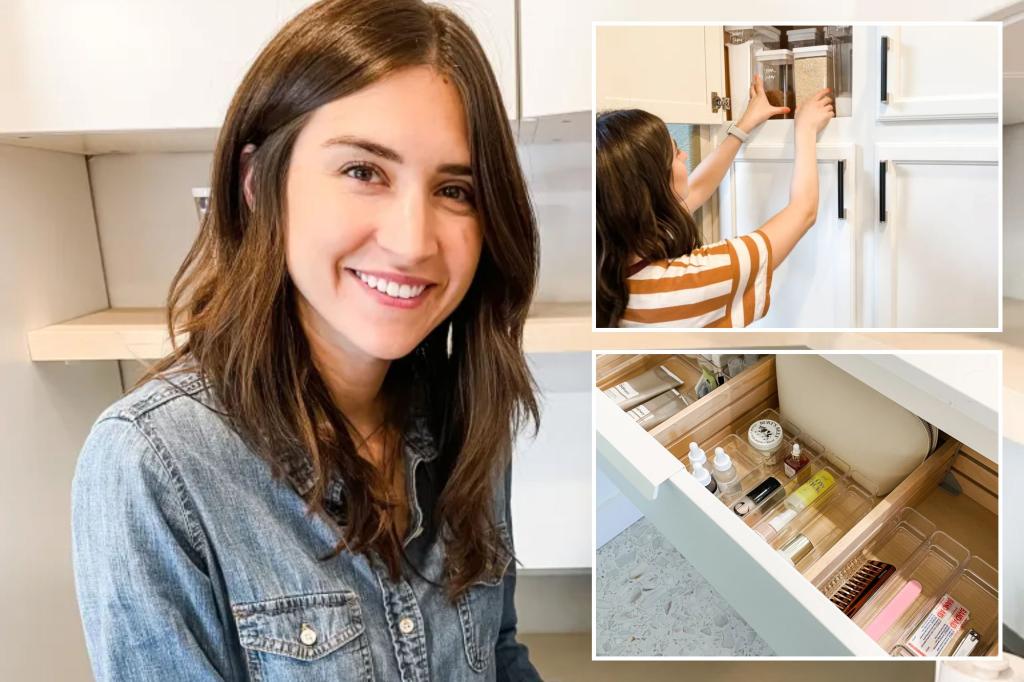A professional organizer has shared the sign you have ‘clutter blindness’ and how to fix it.
Britnee Tanner, 37, runs her own home organization business and spends every day helping people declutter their lives.
She claims there are three mistakes people always make which prevent them from decluttering effectively.
Tanner, from Salt Lake City, Utah, said people often don’t notice the mistakes but they can have a big impact on their general stress levels.
She claims that even if we ‘ignore’ the clutter — known as ‘clutter blindness’ — our brain still registers the mess leaving us feeling “stressed”.
The mom-of-two said tackling obvious clutter like stacks of mail and tangled chargers is a ‘game changer’.
She said it’s possible to go ‘overboard’ on home decor too — like pillows, photo frames and plants.
Tanner claims you should even make time to tackle spaces you can’t see regularly like cupboards and ‘junk’ drawers as they can be filled with clutter.
She said: “In your spaces you can get ‘clutter blindness’ when you’re used to seeing things.
“When you remove the clutter, it opens up the space and creates calmness, and it looks tidier and cleaner.”
According to Tanner, the first mistake people make is to avert their eyes away from ‘visual clutter’ which often lives on sideboards.
Stacks of mail, phone chargers, burned out candles and other random items — even if they’re used regularly — can be ‘clutter culprits’.
She said: “I say — try to imagine yourself as a guest in your own home.
Every morning, the NY POSTcast offers a deep dive into the headlines with the Post’s signature mix of politics, business, pop culture, true crime and everything in between. Subscribe here!
“What do you notice first when you walk through your front door?
“If you’re short on space think of different storage solutions — like vertical space, underbed storage, or any nooks and crannies that aren’t being utilized properly.”
The second mistake people make is overlooking outdated or over-the-top home decor.
Whether that’s scatter cushions, picture frames, plants or nicknacks — Tanner encourages people to question if they “add meaningful value.”
She said: “All of it can accumulate and it crosses into being visual clutter.
“The maximalists out there may not appreciate this! But it can get messy, borderline junky.
“Maybe if there are too many picture frames, or plants, try cycling them out so you still see them all, but not in one go.”
The third mistake people make is overlooking the junk space — whether that’s a kitchen drawer, cupboard or a random area out of sight.
She said while almost everyone has a junk space in some form, and they might be used daily, it’s good to have a clear out regularly.
She suggested using drawer dividers and charger organizers to keep things neat and tidy.
Tanner said: “It does mount up – things like restaurant coupons and extra keys.
“Everyone has those spaces that don’t need to look aesthetically pleasing, but they could still be organized.
“It doesn’t have to be Pinterest perfect but everything doesn’t need to be swimming around in there.”
Tanner advises, for people looking to tackle clutter and disorganization — start with one small space, or one short time period.
Even just by starting with ten minutes is enough to get going — and avoid the “paralyzing overwhelm” that comes with decluttering.
She said: “Just do a little step at a time — one small space, and as you get confident you can move onto others.
“Or for some people a time limit is helpful.”
MISTAKES:
1. MISTAKE – Ignoring visual clutter
SOLUTION – Tackle one surface at a time and keep only what is functional
2. MISTAKE – Neglecting home decor
SOLUTION – Donate things you don’t actually like any more — one man’s trash is another man’s treasure.
3. MISTAKE – Letting ‘junk spaces’ pile up
SOLUTION – Tackle it for a short period at a time –10 or 12 minutes.
Read the full article here







